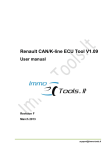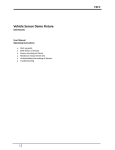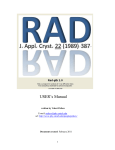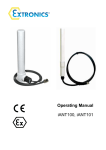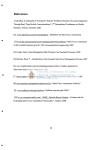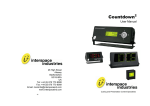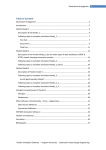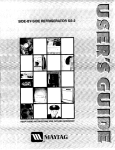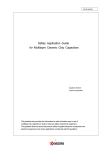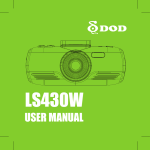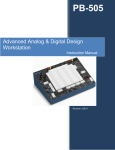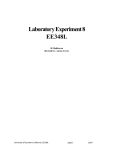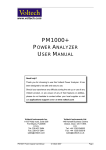Download User Manual - AMEET Electro Systems
Transcript
VECV Electrical / Electronic Components Demo Bench (Basic & Advance Training) User Manual Operating Instructions Safety Rules for Working with Electrical Equipment Start-up Guide Operating the Demo Bench Operating the DC Power Supply Unit Brief Theory of Components Using Components/Fixtures on Demo bench Numericals for better understanding Answer key of Numericals Additional Information 1 VECV Table of Contents Safety Rules for Working with Electrical Equipment … 3 Start-up Guide ……………………………………..……..………..… 4 Checking the Contents Operating the Demo Bench ……………..………………..….… 5 Overview Operating the Demo Bench Operating the DC Power Supply Unit …………….……..…. 6 Overview Operating the Power supply Unit Brief Theory of Components …………………………………… 7 Switch – On/Off & Push to On Fuse – Glass & Maxi Bulb Relay – 4 point & 5 point Resistor – Fixed & Variable Capacitor Diode & Zener Diode Thermistor – NTC & PTC Buzzer Light Emitting Diode (LED) Transistor – NPN & PNP Logic Gates – NOT, OR & AND Integrated Circuits (IC) Using Components/Fixtures on Demo Bench ………. 18 Resistor: In series / parallel combination Capacitor: Charge / discharge circuit Diode: In forward bias / reverse bias Zener Diode: As a voltage regulator Light Emitting Diode Switch: In on/off mode Relay: In NO, NC, NO/NC mode Numericals for better understanding …………………… 25 Bulb Resistors Variable Resistor/Pot Thermistor Buzzer Transistor Logic Gate Answer Key of Numericals .……………..……………..…… 29 Additional Information …………………..…………………… 30 Specifications Troubleshooting 2 VECV Safety Rules for Working with Electrical Equipment A safe work environment is not always enough to control all potential electrical hazards. You must be very cautious and work safely. Do plug power equipment into wall receptacles with power switches in the OFF position. Do plug electrical equipment in OFF condition. Do unplug electrical equipment by grasping the plug and then pulling. Disconnect the power source before servicing or repairing electrical equipment. Stay away from exposed electrical parts unless you are a qualified worker. Keep the work area clean. Leave electrical repairs to qualified personnel. Do not plug power equipment into wall receptacles with power switches in the ON position. Do not unplug electrical equipment in ON condition. Do not plug equipment into defective receptacles. Do not pull or jerk the cord to unplug the equipment. Do not touch equipment or electrical devices unless instructed to do so. Don't place cords near heat or water. Don't touch anything electric with wet hands. 3 VECV Start-up Guide Checking the Contents Electrical Demo Bench unit consists following – 1. Demo Bench - 1 no. 2. DC Power Supply Unit - 1 no. (12V/2A + 24V/1A Regulated) 3. Test Fixtures: A – 14 no. (In PVC box) Switch – ON/OFF (1 unit), Push to ON (1 unit) Glass Fuse – 1A (1 unit) Maxi Fuse – 5A (1 unit) Bulb – 12V (4 unit) Bulb – 24V (4 unit) Relay – 4-point (1 unit) Flashing Relay – 5-point (1 unit) 4. Test Fixtures: B – 17 no. (In PVC box) Resistor – 50Ω/5W (2 unit each), 100Ω/5W (2 unit each), 1kΩ/2W (2 unit each) Variable Resistor (Pot) – 500Ω/1W (1 unit), 1kΩ/1W (1 unit) Capacitor – 0.1µF/50V (1 unit), 470µF/25V (1 unit) Diode – 1A/1000V (1 unit), 6A/400V (1 unit) Zener Diode – 6.2V/1W (1 unit), 9.1V/1W (1 unit) NTC Thermistor – 10kΩ (1 unit) Buzzer – 12 ̴ 24V (2 unit) 5. Test Fixtures: C – 10 no. (In PVC box) LED – Red (1 unit), Green (1 unit) Transistor – NPN (1 unit), PNP (1 unit) Logic Gate – AND (1 unit), OR (1 unit), NOT (1 unit) Integrated Circuits (IC) – 14 pin SMD (1 unit), 20 pin DIP (1 unit), E-PROM (1 unit) 6. Connecting Cables – 20 no. (In PVC box) Red, 430mm long – 3 pcs Black, 430mm long – 3 pcs Yellow, 430mm long – 10 pcs Red, 1000mm long – 2 pcs Black, 1000mm long – 2 pcs 7. Spares – 22 no. (In PVC box) Glass Fuse, 1A – 4 pcs Glass Fuse, 3A – 4 pcs Maxi Fuse, 5A – 2 pcs Bulb, 12V – 4 pcs Bulb, 24V – 4 pcs Diode, 1A – 2 pcs Diode, 6A – 2 pcs 4 VECV Operating the Demo Bench Overview Front view Rear view 1 1 3 2 2 1 2 3 4 > Red Sockets (Internally connected together) > Black Sockets (Internally connected together) > Yellow Sockets (Individual) > Folding Bracket Operating the Demo Bench - Demo bench is a foldable type. - Insert Folding bracket in bottom-plate screw to hold the front in angular position. - Red sockets are internally connected together for +V distribution. - Black sockets are internally connected together for –V distribution. - Yellow sockets are individual for use of fixtures. - In-built fuse at first red socket to protect total demo bench - In-built fuse at last red socket to protect particular circuit on demo bench - Various electrical / electronic components are provided as fixtures. - Electrical / Electronic components & their combinations can be demonstrated on this demo bench to understand it. 5 4 VECV Operating the DC Power Supply Unit Overview Front view Rear view 3 2 5 4 1 1 2 3 4 5 > AC Power Cord > Power On/Off Switch with Neon Indicator > Fuse > Output Sockets for 12V DC & 24V DC > Output-ON Indicator Operating the Unit - Insert the AC power cord plug pin to Ac power outlet. - Switch-on power switch. Its neon indicator will glow. - Also Output-on indicator will glow. - 12V DC & 24V DC voltage is now available at output socket. - Now the unit is ready to use. 6 VECV Brief Theory of Components Switch An electrical switch is a mechanical device usually used to open (disconnect) or close (connect) an electrical circuit. Each set of contacts can be in one of two states: either 'closed' meaning the contacts are touching and electricity can flow between them, or 'open', meaning the contacts are separated and the switch is non-conducting. The terms "make" for closure of contacts and "break" for opening of contacts are also widely used. Switches play an important role in electronic, to stop the flow of current or to pass the current. Switches are of different types. The common types are toggle, rotary, slide, snap and rocker and also classified according to number of poles & throws like SPST, SPDT etc. The terms pole and throw are also used to describe switch contact variations. The mechanism actuating the transition between these two states (open or closed) can be either a "toggle" (flip switch for continuous "on" or "off") or "momentary" (push-for "on" or push-for "off") type. (a) Toggle Switch SPST SPDT DPST DPDT (b) Push switch A push switch is a momentary or non-latching switch which causes a temporary change in the state of an electrical circuit only while the switch is physically actuated. An automatic mechanism (i.e. a spring) returns the switch to its default position immediately afterwards, restoring the initial circuit condition. There are two types: A push to make switch allows electricity to flow between its two contacts when held in. When the button is released, the circuit is broken. This type of switch is also known as a Normally Open (NO) Switch. Examples: doorbell, computer case power switch, calculator buttons, individual keys on a keyboard Push-to-make switch symbol A push to break switch does the opposite, i.e. when the button is not pressed, electricity can flow, but when it is pressed the circuit is broken. This type of switch is also known as a Normally Closed (NC) Switch. Examples: Fridge Light Switch, Alarm Switches in Fail-Safe circuits Push-to-break switch symbol 7 VECV Fuse In electronics and electrical engineering, a fuse is a type of low resistance resistor that acts as a sacrificial device to provide overcurrent protection, of either the load or source circuit. A fuse interrupts excessive current (blows) so that further damage by overheating or fire is prevented. Fuses are manufactured in a wide range of current and voltage ratings to protect wiring systems and electrical equipment. The fuse element is made of zinc, copper, silver, aluminium, or alloys to provide stable and predictable characteristics. Automotive fuses are used to protect the wiring and electrical equipment for vehicles. Automotive fuses can be mounted in fuse blocks, inline fuse holders, or fuse clips. Glass Fuse Maxi Fuse Light Bulb A bulb converts electrical energy into light. A Light Bulb is an electric light which produces light with a wire filament heated to a high temperature by an electric current passing through it, until it glows. The hot filament is protected from oxidation with a glass or quartz bulb that is filled with inert gas or evacuated. The light bulb is supplied with electrical current by feed-through terminals or wires embedded in the glass. Most bulbs are used in a socket which provides mechanical support and electrical connections. Light bulbs for automobiles are made in several standardized series. 8 VECV Relay A relay is an electromagnetic device and it functions as an electronically operated switch. Most of relays are operated electro-magnetically. When current flows through coil, electromagnetic field is generated, this attracts the armature which in turn opens or closes the electrical contacts. A common type of relay is having a normally open (N/O) and a normally closed (N/C) contact. Relays are used where it is necessary to control a circuit by a low-power signal (with complete electrical isolation between control and controlled circuits), or where several circuits must be controlled by one signal. Simple electromagnetic relay consists of a coil of wire surrounding a soft iron core, an iron yoke, a movable iron armature, and one or more sets of contacts. 4-point Relay 5-point Relay Resistor A resistor is a passive two-terminal component. The current through a resistor is directly proportion to the voltage across the resistor's terminals. Resistors are required in electronic circuits to limit the current, to drop the voltage and to divide the voltage. The symbol of fixed resistors is as shown – OR The ohm (Ω) is the unit of resistance. The behaviour of an ideal resistor is dictated by the relationship specified by Ohm’s law: V = I * R In a series configuration, the current through all of the resistors is the same, but the voltage across each resistor will be in proportion to its resistance. The potential difference (voltage) seen across the network is the sum of those voltages, thus the total resistance can be found as the sum of those resistances: Resistors in a parallel configuration are each subject to the same potential difference (voltage), however the currents through them add. Thus the equivalent resistance (Req) of the network can be computed: 9 VECV The parallel equivalent resistance can be represented in equations by two vertical lines "||" as a simplified notation. For the case of two resistors in parallel, this can be calculated using: A resistor network that is a combination of parallel and series connections can be broken up into smaller parts that are either one or the other. For instance, The power P dissipated by a resistor is calculated Variable Resistor / Potentiometer A potentiometer, informally a pot, is a three-terminal resistor with a sliding or rotating contact that forms an adjustable voltage divider. If only two terminals are used, one end and the wiper, it acts as a variable resistor or rheostat. Potentiometers are commonly used to control electrical devices such as volume controls on audio equipment. Potentiometers operated by a mechanism can be used as position transducers. Potentiometers are rarely used to directly control significant power (more than a watt), since the power dissipated in the potentiometer would be comparable to the power in the controlled load. The potentiometer can be used as a voltage divider to obtain a manually adjustable output voltage at the slider (wiper) from a fixed input voltage applied across the two ends of the potentiometer. This is their most common use. 10 VECV Capacitor A capacitor is a passive two-terminal component used to store energy. Capacitor contains at least two conductors separated by a dielectric (insulator). Their capacity is measured in “Farad”. They are available in typical range of picofarad (pF) to microfarad (uF). Symbol of capacitor is as – Polarised capacitors must be connected in correct way. A capacitor is used with a resistor in a timing circuit. It can also be used as a filter, to block DC signals but pass AC signals. Capacitance This is a measure of a capacitor's ability to store charge. A large capacitance means that more charge can be stored. Capacitance is measured in farads, symbol F. However 1F is very large, so prefixes are used to show the smaller values. Three prefixes (multipliers) are used, µ (micro), n (nano) and p (pico): µ means 10-6 (millionth), so 1000000µF = 1F n means 10-9 (thousand-millionth), so 1000nF = 1µF p means 10-12 (million-millionth), so 1000pF = 1nF Capacitor Number Code A number code is often used on small capacitors where printing is difficult: the 1st number is the 1st digit, the 2nd number is the 2nd digit, the 3rd number is the number of zeros to give the capacitance in pF. Ignore any letters - they just indicate tolerance and voltage rating. For example: 102 means 1000pF = 1nF (not 102pF!) For example: 472J means 4700pF = 4.7nF (J means 5% tolerance). Capacitors in a parallel configuration each have the same applied voltage. Their capacitances add up. Connected in series, the schematic diagram reveals that the separation distance, adds up. The capacitors each store instantaneous charge build-up equal to that of every other capacitor in the series. The total voltage difference from end to end is apportioned to each capacitor according to the inverse of its capacitance. The entire series acts as a capacitor smaller than any of its components. 11 VECV Diode A diode is a two-terminal component. It is the first semiconductor electronic device. The diode is made from a single p–n junction. At the junction of a p-type and an n-type semiconductor there forms a region called the depletion region which blocks current conduction from the n-type region to the p-type region, but allows current to conduct from the p-type region to the n-type region. Thus, when the device is forward biased, with the p-side at higher electric potential, the diode conducts current easily; but the current is very small when the diode is reverse biased. Today most diodes are made of silicon. The most common function of a diode is to allow an electric current to pass in one direction (called the diode's forward direction), while blocking current in the opposite direction (the reverse direction). A diode can be used as switch or as a rectifier. In Forward bias, anode is connected to positive terminal & cathode to negative terminal of a DC voltage source. Here diode acts as a closed switch. In Reverse bias, anode is connected to negative terminal & cathode to positive terminal of a DC voltage source. Here diode acts as an open switch. Zener Diode A Zener diode is a special kind of diode which allows current to flow in the forward direction same as an ideal diode, but will also permit it to flow in the reverse direction when the voltage is above a certain value known as the breakdown voltage / Zener knee voltage / Zener voltage. The Zener diode is therefore ideal for applications such as the generation of a reference voltage or as a voltage stabilizer for low-current applications. Zener diode is designed to get stable voltage and it is operated in reverse bias only. By adjusting the doping level, zener diodes of different voltages from 2 to 200V and with different wattage are manufactured. Following is a simple zener regulator. In this circuit, an input voltage, U IN, is regulated down to a stable output voltage UOUT. 12 VECV Thermistor A thermistor is a type of resistor whose resistance varies significantly with temperature. The word is a combination of thermal and resistor. Thermistors are widely used as inrush current limiters, temperature sensors, self-resetting overcurrent protectors. Thermistors differ from resistance temperature detectors (RTDs) in that the material used in a thermistor is generally a ceramic or polymer, while RTDs use pure metals. The temperature response is also different; RTDs are useful over larger temperature ranges, while thermistors typically achieve a higher precision within a limited temperature range, typically −90 °C to 130 °C. NTC Many NTC thermistors are made from a pressed disc, rod, plate, bead or cast chip of a semiconductor such as a sintered metal oxide. They work because raising the temperature of a semiconductor increases the number of active charge carriers - it promotes them into the conduction band. The more charge carriers that are available, the more current a material can conduct. NTC thermistors are used as resistance thermometers in low-temperature measurements. PTC Most PTC thermistors are of the "switching" type, which means that their resistance rises suddenly at a certain critical temperature. The devices are made of a doped polycrystalline ceramic containing barium titanate (BaTiO3) and other compounds. PTC thermistors can be used as current-limiting devices for circuit protection, as replacements for fuses. Buzzer A buzzer or beeper is an audio signalling device, which may be mechanical, electromechanical, or piezoelectric. 13 VECV Typical uses of buzzers and beepers include alarm devices, timers. The word "buzzer" comes from the rasping noise that electromechanical buzzers made. A piezoelectric element may be driven by an oscillating electronic circuit or other audio signal source, driven with a piezoelectric audio amplifier. Sounds commonly used to indicate that a button has been pressed are a click, a ring or a beep. These devices are output transducers converting electrical energy to sound. They contain an internal oscillator to produce the sound which is set at about 400Hz for buzzers. Buzzers have a voltage rating but it is only approximate, for example 6V and 12V buzzers can be used with a 9V supply. Their typical current is about 25mA. Buzzers must be connected the right way round, their red lead is positive (+). Light Emitting Diode (LED) A light-emitting diode (LED) is a semiconductor light source. When LED is in forward bias it emits light instead of heat generated by a normal diode. Their working voltage drop is 1 to 2V and current is 5 to 25mA. A series resistance is always required with LED to limit the current. LEDs are available in different colours like Red, Green, Yellow, white etc. Symbol for LED is as Light-emitting diodes are used in applications as diverse as replacements for aviation, automotive lighting (particularly brake lamps, turn signals and indicators) as well as in traffic signals. The wavelength of the light emitted, and thus its colour depends on the band gap energy of the materials forming the p-n junction. Transistor A transistor is a semiconductor device used to amplify and switch electronic signals and electrical power. Bipolar junction transistors are formed from two p–n junctions, in either N–P–N / P–N–P configuration. The middle, or base, region between the junctions is typically very narrow. The other regions, and their associated terminals, are known as the emitter and the collector. A small current injected through the junction between the base and the emitter changes the properties of the base-collector junction so that it can conduct current even though it is reverse biased. This creates a much larger current between the collector and emitter, controlled by the baseemitter current. There are two types of transistors, NPN & PNP, which have slight differences in how they are used in a circuit. A bipolar transistor has terminals labelled base, collector, and emitter. Today, some transistors are packaged individually, but many more are found embedded in integrated circuits. 14 VECV The essential usefulness of a transistor comes from its ability to use a small signal applied between one pair of its terminals to control a much larger signal at another pair of terminals. This property is called gain. It can produce a stronger output signal, a voltage or current, that is proportional to a weaker input signal; that is, it can act as an amplifier. Alternatively, the transistor can be used to turn current on or off in a circuit as an electrically controlled switch, where the amount of current is determined by other circuit elements. Transistor configuration basics The terminology used for denoting the three basic transistor configurations indicates the transistor terminal that is common to both input and output circuits. This gives rise to the three terms: common base, common collector and common emitter. Common base transistor configuration: This transistor configuration provides a low input impedance while offering a high output impedance. Although the voltage is high, the current gain is low and the overall power gain is also low when compared to the other transistor configurations available. The other salient feature of this configuration is that the input and output are in phase. Common collector transistor configuration: This transistor configuration is also known as the emitter follower because the emitter voltage follows that of the base. Offering a high input impedance and a low output impedance it is widely used as a buffer. The voltage gain is unity, although current gain is high. The input and output signals are in phase. Common emitter transistor configuration: This transistor configuration is probably the most widely used. The circuit provides a medium input and output impedance levels. Both current and voltage gain can be described as medium, but the output is the inverse of the input, i.e. 180° phase change. This provides a good overall performance and as such it is often thought of as the most widely used configuration. 15 VECV TRANSISTOR CONFIGURATION SUMMARY TABLE TRANSISTOR CONFIGURATION COMMON BASE COMMON COLLECTOR COMMON EMITTER Voltage gain High Low Medium Current gain Low High Medium Power gain Low Medium High Input / output phase relationship 0° 0° 180° Input resistance Low High Medium Output resistance High Low Medium Logic Gate In electronics, a logic gate is an idealized or physical device, it performs a logical operation on one or more logical inputs, and produces a single logical output. Digital electronics circuits operate at fixed voltage levels corresponding to a logical 0 or 1 (see binary). An inverter circuit serves as the basic logic gate to swap between those two voltage levels. AND gate: It is a basic digital logic gate that implements logical conjunction - it behaves according to the truth table to the right. A HIGH output (1) results only if both the inputs to the AND gate are HIGH (1). If neither or only one input to the AND gate is HIGH, a LOW output results. In another sense, the function of AND effectively finds the minimum between two binary digits, just as the OR function finds the INPUT OUTPUT maximum. Therefore, the output is always 0 except when all the inputs are 1s. A B A AND B 0 0 0 0 1 0 1 0 0 1 1 1 The AND gate with inputs A and B and output Y implements the logical expression. Y = A * B OR gate: It is a digital logic gate that implements logical disjunction - it behaves according to the truth table to the right. A HIGH output (1) results if one or both the inputs to the gate are HIGH (1). If neither input is high, a LOW output (0) results. In another sense, the function of OR effectively finds the maximum between two binary digits, just as the complementary AND function finds the minimum. INPUT A B 0 0 0 1 1 0 1 1 OUTPUT A+B 0 1 1 1 The OR gate with inputs A and B and output Y implements the logical expression. Y = A + B 16 VECV NOT / Inverter gate: In digital logic, an inverter or NOT gate is a logic gate which implements logical negation. The inverter is a basic building block in digital electronics. INPUT A 0 1 OUTPUT NOT A 1 0 The NOT gate with input A and output Y implements the logical expression. Y = Ā Integrated circuit An integrated circuit (IC) is a set of electronic circuits on one small plate (chip) of semiconductor material. This can be made much smaller than a discrete circuit made from independent components. ICs can be made very compact, having up to several billion transistors and other electronic components in an area the size of a fingernail. There are two main advantages of ICs over discrete circuits: cost and performance. Cost is low because the chips, with all their components, are printed as a unit by photolithography rather than being constructed one transistor at a time. Performance is high because the components switch quickly and consume little power (compared to their discrete counterparts) as a result of the small size and close proximity of the components. Integrated circuits are used in virtually all electronic equipment today and have revolutionized the world of electronics. Computers, mobile phones, and other digital home appliances are now inextricable parts of the structure of modern societies, made possible by the low cost of producing integrated circuits. Commercial circuit packaging quickly moved to the dual in-line package (DIP), first in ceramic and later in plastic. Surface-mount technology was developed in the 1960s and became widely used in the late 1980s. Package: dual in-line package (DIP) Package: Surface Mount Device (SMD) EPROM 17 VECV An EPROM, or erasable programmable read only memory, is a type of memory chip that retains its data when its power supply is switched off. In other words, it is non-volatile. Once programmed, an EPROM can be erased by exposing it to strong ultraviolet light source. EPROMs are easily recognizable by the transparent fused quartz window in the top of the package, through which the silicon chip is visible, and which permits exposure to UV light during erasing. Using Components / Fixtures on Demo Bench Preparation Take a pair of wire (Red/Black 1, metre long), insert banana plugs to DC power supply unit at 12V socket. Insert other end Red plug to Demo bench’s Red socket and Black plug to Demo bench’s Black socket. Now 12V DC supply is available at Demo bench to use. Note: Always use 12V DC supply unless otherwise specified. Following are the some examples of how to use components on Demo bench. One can create his own combinations and ideas. ON / OFF (Toggle) Switch: - Connect bulb through switch to 12V supply. - If switch is off / open, bulb will not glow. - If switch is on / closed, bulb will glow. - Here switch is used to make / break the circuit. Push-to -ON Switch: - Connect bulb through switch to 12V supply. - If switch is not pressed (open), bulb will not glow. - If switch is pressed (closed), bulb will glow. - Here switch is used to make / break the circuit when it is pressed. Glass / Maxi Fuse: - Connect bulb through fuse to 12V supply. - If fuse is ok (not blown), bulb will glow. - If fuse is not ok (blown), bulb will not glow. - Here fuse is used to protect the circuit. Bulb 12V / 24V: 18 VECV - Use 12V supply for 12V bulb & 24V supply for 24V bulb. - Connect one bulb to supply, see brightness / intensity. - Add another bulb in series with this and observe brightness / intensity. - Add another bulb in parallel with this and observe brightness / intensity. - Repeat above with one more bulb. - Measure Voltage, Current & Resistance in each combination. 4-point Relay In this relay, only NO (Normal Open) contact is provided. When voltage is applied to relay coil, it gets energised and changes NO contact to close. - Place 4-point Relay fixture on Demo bench. - Connect COIL (86) to -12Volts by black connecting cable. - Connect COIL (85) to +12Volts through on/off switch by red connecting cables. - keep switch in OFF position. - Connect NO (87) to +12Volts by red connecting cable. - Connect NO (30) to Bulb (12V) by yellow connecting cable. - Connect other end of Bulb (12V) to -12Volts by black connecting cable. - Now Bulb does not glow, since relay is OFF. - Change switch to ON position. - Relay gets energised & changes its state. - Now Bulb glows. 5-point Flashing Relay In this relay, NC (Normal Closed) contact is provided along with NO contact. When voltage is applied to relay coil, it gets energised and changes NO contact to close and NC contact to open. A flasher circuit is used to relay ON & OFF periodically. You can observe make & break of contacts. - Place 5-point Relay fixture on Demo bench. - Connect – COIL to -12Volts by black connecting cable. - Connect +COIL to +12Volts through on/off switch by red connecting cables. - keep switch in OFF position. 19 VECV - P (Pole) is internally connected to +12Volts. So it does not require any external connection. - Connect NC to Bulb-A (12V) by yellow connecting cable. - Connect other end of Bulb-A (12V) to -12Volts by black connecting cable. - Connect NO to Bulb-B (12V) by yellow connecting cable. - Connect other end of Bulb-B (12V) to -12Volts by black connecting cable. - Change switch to ON position. - Relay gets energised & changes its state periodically. In-built LEDs also shows the state. - When relay is OFF, only Bulb-A glows. - When relay is ON, only Bulb-B glows. Resistor: In series / parallel combination Resistors can be used as individual, in series, in parallel and in series-parallel combination. Current/voltage in the circuit can be measured on multi-meter or calculated using formula. Following are the some circuits – Variable Resistor / Potentiometer Measuring resistance with Multi-meter - Place Variable Resistor / Pot on Demo bench. - Measure resistance between P1&P3 with & without varying knob. - Measure resistance between P2&P1 with & without varying knob. - Measure resistance between P2&P3 with & without varying knob. From readings, you will observe that - resistance between P1&P3 is fixed. - resistance between P2&P1 / P2&P3 is variable. Measuring voltage with Multi-meter - Place Variable Resistor / Pot on Demo bench. - Connect P1 to +12Volts by red connecting cable. - Connect P3 to -12Volts by black connecting cable. - Measure voltage between P2&P3 at various knob positions. From readings, you will observe that voltage varies between 0 to 12V. So variable resistor/Pot can be used as voltage divider. Capacitor: Charge / discharge circuit A series circuit containing only a resistor, a capacitor, a switch and a constant DC source of voltage V0 is known as a charging circuit. Here Vo=12V, R=1kΩ, C=470µF. 20 VECV Connect voltmeter across capacitor. With switch open, capacitor is not charged (discharged) and voltmeter reads zero volts. When switch is closed, capacitor charges slowly through resistor and voltmeter shows the voltage. Now open the switch, capacitor still holds the charge and voltmeter shows the voltage. To discharge capacitor, wait for some time or short the capacitor terminals for a moment. Diode: In forward bias / reverse bias In forward bias, current flows through diode and Bulb/LED glows. Here diode acts as closed switch. In reverse bias, current do not flow through diode, so bulb/LED do not glow. Here diode acts as open switch. Here V=12V, Bulb=LED Zener Diode: As a voltage regulator In this circuit, an input voltage, UIN =12V, is regulated down to a stable output voltage UOUT =6.2V. Here UIN =12V, R=1KΩ, D=6.2V zener diode. Connect voltmeter across zener diode. Voltmeter will read zener voltage. If you use UIN =24V, voltmeter will read same voltage. You can do same experiment with 9.1V zener diode. Thermistor A multi-meter can be used to find the resistance at various temperature, these are some typical readings for 10kΩ NTC type: Icy water 0°C : High resistance, about 28kΩ Room temperature 25°C : Medium resistance, about 10kΩ. Boiling water 100°C : Low resistance, about 1kΩ. Buzzer - Connect 12V / 24V supply to Buzzer. It sounds. 21 VECV Light Emitting Diode Connect LED to 12V supply. LED will glow. Note that LED fixture has in-built series resistor. Series resistor can be on either side of LED. Transistor Testing with a Multi-meter Use a multi-meter to check each pair of leads for conduction. Set a digital multi-meter to diode test range. Test each pair of leads both ways (six tests in total): The base-emitter (BE) junction should behave like a diode and conduct one way only. The base-collector (BC) junction should behave like a diode and conduct one way only. The collector-emitter (CE) should not conduct either way. The diagram shows how the junctions behave in an NPN transistor. The diodes are reversed in a PNP transistor but the same test procedure can be used. Transistor as simple switch Connect the transistor into the circuit shown, which uses the transistor as a switch. The supply voltage can be 12V or 24V. In-built 1k resistor is connected in series with B (base) and 10Ω resistor is connected in series with C (collector) to avoid damage to the transistor. So just connect switch to B and bulb to C. If the transistor is OK the LED should light when the switch is pressed and not light when the switch is released. 22 VECV To test a PNP transistor use the same circuit but reverse the LED and the supply voltage. NOT / Inverting Gate The NOT gate with input A and output Y implements the logical expression. Y = Ā - Place NOT gate fixture on Demo bench. - Connect –V to -12Volts by black connecting cable. - Connect +V to +12Volts by red connecting cables. - Keep switch IN A at position LO. - Observe OUT Y LED. - Keep switch IN A at position HI. - Observe OUT Y LED. - Verify the Truth table with observations. - You can also measure IN & OUT voltages at respective terminals with Multi-meter. OR Gate The OR gate with inputs A and B and output Y implements the logical expression. Y = A + B - Place OR gate fixture on Demo bench. - Connect –V to -12Volts by black connecting cable. - Connect +V to +12Volts by red connecting cables. - Keep switch IN A & IN B at position LO. - Observe OUT Y LED. - Keep switch IN B at position HI. - Observe OUT Y LED. - Keep switch IN B at position LO & switch IN A at position HI. - Observe OUT Y LED. - Keep switch IN A & IN B at position HI. - Observe OUT Y LED. - Verify the Truth table with observations. - You can also measure IN & OUT voltages at respective terminals with Multi-meter. AND Gate The AND gate with inputs A and B and output Y implements the logical expression. Y = A * B - Place AND gate fixture on Demo bench. - Connect –V to -12Volts by black connecting cable. - Connect +V to +12Volts by red connecting cables. 23 VECV - Keep switch IN A & IN B at position LO. - Observe OUT Y LED. - Keep switch IN B at position HI. - Observe OUT Y LED. - Keep switch IN B at position LO & switch IN A at position HI. - Observe OUT Y LED. - Keep switch IN A & IN B at position HI. - Observe OUT Y LED. - Verify the Truth table with observations. - You can also measure IN & OUT voltages at respective terminals with Multi-meter. SMD IC The HCF4066B is a monolithic integrated circuit fabricated in Metal Oxide Semiconductor technology. It is a QUAD BILATERAL SWITCH intended for the transmission or multiplexing of analog or digital signals. It consists of four independent bilateral switches. A single control signal is required per switch. DIP IC The LM339N is a monolithic quad of independently functioning comparators designed to operate from single power supply over a wide voltage range. The open collector output configuration allows the device to be used in wired-OR configurations, such as a window comparators. In addition it may be used as a single pole switch to ground. Power dissipation with all four comparators in the OFF state is typically 4mW from a 5V supply. APPLICATIONS INCLUDE: — Limit Comparators — Simple Analog-to-Digital Converters (ADCs) — Pulse, Square-wave, and Time Delay Generators — Multivibrators and High-Voltage Digital Logic Gates E-PROM IC The M27C512 is a 512 Kbit EPROM offered in UV (ultra violet erase). It is ideally suited for applications where fast turn-around and pattern experimentation are important requirements and is organized as 65,536 by 8 bits. It has transparent lid which allows the user to expose the chip to ultraviolet light to erase the bit pattern. A new pattern can then be written to the device by following the programming procedure. 24 VECV Numericals for better understanding 1) Connect one 12V bulb to 12V supply. Observe its brightness. Add another 12V bulb in series with it as shown below. Observe their brightness. 2) Connect one 12V bulb to 12V supply. Observe its brightness. Add another 12V bulb in parallel with it as shown below. Observe their brightness. 3) Connect two 12V bulb in parallel to 12V supply. Observe its brightness. Add another 12V bulb in parallel with it as shown below. Observe their brightness. 4) Connect two 12V bulb in series to 12V supply. Measure the voltage across each bulb. Also measure the current through them. 25 VECV 5) Connect two 12V bulb in parallel to 12V supply. Measure the current through each bulb. Also measure the voltage across them. 6) Connect any two resistors in series. Calculate and measure total resistance. 7) Connect any three resistors in series. Calculate and measure total resistance. 8) Connect any two resistors in parallel. Calculate and measure total resistance. 9) Connect any three resistors in parallel. Calculate and measure total resistance. 10) Connect any four resistors in series & parallel as below. Calculate and measure total resistance. 11) Connect any three resistors in series and measure voltage across each resistor and total current. 12) Connect any three resistors in parallel and measure current through each resistor and total current. 26 VECV 13) Apply voltage 12V to P1 & P3 terminals of Pot. Measure the voltage at P2 & P3 by varying pot knob from minimum to maximum. Repeat the same with 24V. 14) Study the temperature chart of 10K NTC thermistor. 15) Connect 12V supply to Buzzer and observe tone & volume/sound level. Now connect 24V supply to Buzzer and observe tone & volume/sound level. Note the difference. 16) Study the circuit diagram in which NPN transistor is used as an amplifier. Also study below circuit theory. 27 VECV The common-emitter amplifier is designed so that a small change in voltage (Vin) changes the small current through the base of the transistor; the transistor's current amplification combined with the properties of the circuit mean that small swings in Vin produce large changes in Vout. By controlling the number of electrons that can leave the base, the number of electrons entering the collector can be controlled. Collector current is approximately β (common-emitter current gain) times the base current. It is typically greater than 100 for small-signal transistors but can be smaller for high-power transistors. 17) Construct following circuit with NPN transistor. Use 12V bulb for 12V supply, 1KΩ resistor instead of 10kΩ and 1KΩ pot instead of 10kΩ pot. Vary pot knob and observe bulb brightness. Repeat same with 24V Bulb & 24V supply. 18) Study the following logic circuit and draw its truth table. 19) Study the following combinational logic circuit and draw truth table for output Q. 20) Study the following combinational logic circuit and find out logic expression for output Y. 21) Study the following combinational logic circuit and find out logic expression for output Y. 28 VECV 22) Explain the working of following circuit diagram. For which inputs, the buzzer will be ON? Answer key of Numericals 1) Bulb brightness decreases in series connection. 2) Bulb brightness remains same in parallel connection. 3) Bulb brightness remains same in parallel connection. If total current drawn by bulb exceeds power supply cpacity, then only bulb brightness will decrease. 6) Total resistance = a + b 7) Total resistance = R1 + R2 + R3 8) ‘____1 Total Resistance = ‘__1_ + ‘__1_ Ra Rb 9) ‘____1 Total Resistance = ‘__1_ + ‘__1_ + ‘__1_ R1 R2 R3 10) 13) Voltage between P2 & P3 varies from 0 to 12V / 24V. 15) Tone of buzzer remains same, though supply voltage changes. Only volume / sound level increses as supply voltage increases. 17) If pot resistance is minimum/zero, base is connected to 0V. So transistor is in OFF state & bulb does not glow. IF pot is varied slowly, base current starts flowing and transistor starts conducting & bulb glows slowly. Thus by controlling base current, collector current / bulb brightness can be controlled. 18) Truth table 29 VECV 19) Truth table A 0 0 1 1 B 0 1 0 1 C 0 0 0 1 Q 1 1 1 0 _____ 20) Y = (A • B) • C 21) 22) B = (K+H) •D = K•D + H•D Additional Information Specifications 1. Demo Bench -- a) Type: Foldable b) Red row: 1 row with 5 sockets (Internally connected together) c) In-built fuse at first & last Red socket d) Black row: 1 row with 7 sockets (Internally connected together) e) Yellow row: 7 rows with 49 sockets (Individual) f) Dimensions: 360x485x300mm (W x H x D) 2. DC Power Supply Unit – a) SMPS based with individual TIPPO SMPS for 12V & 24V b) Aux. supply: 230VAC +/- 20% b) Output 1: 12VDC @ 2A c) Output 2: 24VDC @ 1A d) Protection: In-built short-circuit & overload protection e) Fuse: 3A (20mm) f) Dimensions: 120x80x160mm (W x H x D) 3. Assorted Test Fixtures – a) Switch: SPDT 3A/250V, Push to On b) Fuse: Glass 20mm 1A/250V, Maxi 5A c) Bulb: 12V/5W Philips, 24V/3.4W Comet d) Relay: 4 point Minda, 5 point OEN with IC 555 flasher circuit e) Resistor: 50Ω/5W CRC, 100Ω/5W CRC, 1KΩ/2W Thakor f) Variable Resistor / Potentiometer: 500Ω/1W Pankaj, 1kΩ/1W Pankaj g) Capacitor: 0.1µF/50V AES, 470µF/25V Keltron h) Diode: 1A/1000V 1N4007 MIC, 6A/400V MIC i) Zener Diode: 6.2V/1W Philips, 9.1V/1W Philips j) NTC Thermistor: 10kΩ k) Buzzer: 12 - 24V ION l) LED: ø5mm Round, Red/Green colour with built-in series resistor -10KΩ/1W for Red LED & 2.2KΩ/1W for Green LED m) Transistor: NPN CL100 CDIL, PNP CK100 CDIL with built-in series resistor 1KΩ/2W for Base (B) & 10Ω/2W for Collector (C) n) Logic Gates: NOT using IC 4069, OR using IC 4071, AND using IC 4081 30 VECV o) IC: 14pin SMD IC TC4066, 14pin DIP IC LM339N, EPROM IC M27C512 4. Connecting Cables – a) Red: Make -Polycab, Type -1.5sq.mm, Length -430mm, Banana plug -4mm b) Black: Make -Polycab, Type -1.5sq.mm, Length -430mm, Banana plug -4mm c) Yellow: Make -Polycab, Type -1.5sq.mm, Length -430mm, Banana plug -4mm d) Red: Make -Polycab, Type -1.5sq.mm, Length -1mtr, Banana plug -4mm e) Black: Make -Polycab, Type -1.5sq.mm, Length -1mtr, Banana plug -4mm Troubleshooting Demo Bench - No output voltage – a) Check the front-side fuse DC Power Supply Unit - No output voltage / Green LED does not glow / Red indicator does not glow – a) Check the AC power supply to unit b) Check the back-side fuse 31
































